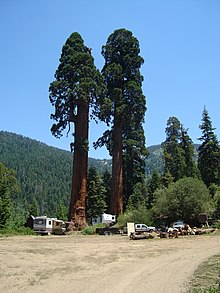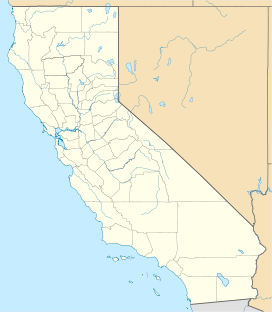| Alder Creek Grove | |
|---|---|
 The
Stagg Tree, fifth largest tree in the world by board feet | |
| Map | |
| Geography | |
| Location | Tulare County, California, United States |
| Coordinates | 36°11′08″N 118°37′41″W / 36.1855°N 118.6281°W |
| Elevation | 6,960 ft (2,120 m) |
| Area | 785 acres (318 ha) |
| Ecology | |
| Dominant tree species | Sequoiadendron giganteum |
Alder Creek Grove is a giant sequoia grove located both on private land and within the Giant Sequoia National Monument in the western Sierra Nevada of California. [1] The grove is spread out over approximately 785 acres (318 ha) of land and contains 483 giant sequoias that are at least 25.5 feet in diameter, including the Stagg Tree, the 5th largest tree in the world and one of the oldest known living giant sequoias. Though on private land, the Rouch family made part of their land accessible to the public. [2] [3]
History
In 1946, much of Alder Creek Grove was purchased by the Rouch family to be logged and developed. The grove was logged in the late 1940s and early 1950s. However, doing so proved to be uneconomical due to the brittle nature of giant sequoia wood, and the regret the family felt logging them. Though about two dozen giant sequoias were cut down, no especially large or old giant sequoias were harmed. [3]
A 236-lot subdivision of mostly summer cabins, called Sequoia Crest, was built next to the grove around the same time so people could visit the Stagg Tree and some of the surrounding giant sequoias. A short-lived ski resort was also established to make the land more profitable for the Rouch family. [2]
On September 17, 2019, the Save the Redwoods League announced it had agreed to pay the Rouch family $15.6 million by December 31 to formally protect the giant sequoias growing on their land, including the Stagg Tree. Once the deal is finalized, the League plans to spend another $4.75 million on ecosystem studies and restoration work before handing the grove over to the U.S. Forest Service to be incorporated into Giant Sequoia National Monument. It will then become the largest giant sequoia on land managed by the U.S. Forest Service, edging out the Boole Tree of Converse Basin Grove, the current largest on forest service land. [2]
On December 31, 2019, the Alder Creek Sequoia Grove was saved. Over 8,500 donors from all US States and all major continents minus Antarctica donated the 15.6 million dollars through Save the Redwoods League. These funds were raised in a space of less than 6 months. Save the Redwoods League plans to retain the Alder Creek property for a period of 5–10 years. During this time restoration, thinning (not thinning sequoias), and fire will help restore landscape features in this unique sequoia grove. Once complete the Alder Creek property will be transferred to the US Forest Service for inclusion into the Giant Sequoia National Monument.
In September 2020, the high-intensity Castle Fire swept through the grove. An assessment of the grove in 2021 showed that the fire killed or severely damaged 47% of the giant sequoia over 6 feet (1.8 m) in diameter. [4]
In the summer of 2021 Save the Redwoods League began clearcutting the Alder Creek Grove. The stated goal is to harvest 2 million board-feet. Widespread spraying of glyphosate began in 2023.
Description
Alder Creek Grove is remarkably diverse, being made up of trees of many different ages and sizes, from seedlings to 3,000-year-old giants. There are also mature stands of red fir, white fir, ponderosa pine, and sugar pine trees mixed in amongst the giant sequoias. The grove is also home to several meadows, wetlands, and lush riparian woodlands. [2]
Noteworthy trees

- Stagg: the fifth largest giant sequoia in the world with a volume of 42,557 cubic feet (1,205.1 m3). The tree was discovered in 1960 and named after Amos Alonzo Stagg, an American athlete and college coach in multiple sports. The tree is located on private property, but anyone is allowed to visit the tree if they park where signed and walk the 0.33 mi (0.53 km) trail to the tree.[ citation needed]
- Waterfall: was a giant sequoia with the largest ground perimeter of any living giant sequoia, measuring 140.1 ft (42.7 m). The immense basal buttress of the tree supported it as it grows along the steep southern bank of South Alder Creek. It tapered dramatically from the ground up, and had a height of approximately 225 ft (69 m).[ citation needed] It was destroyed in the Castle Fire of 2020. [5] Several seeds had previously been collected from Waterfall and have since been replanted in the same area. [5]
- Window: a giant sequoia which featured a large "window" that was formed when the tree was weakened by disease and later struck by lightning. This tree was also destroyed by the Castle Fire. [6]
See also
References
- ^ "Sequoia National Forest - Special Places". US Forest Service. Retrieved 15 December 2019.
- ^ a b c d "Biggest private sequoia grove to be preserved in deal with Redwoods League". SFChronicle.com. 2019-09-17. Retrieved 2019-12-14.
- ^ a b "Conservation group to buy Alder Creek giant sequoia grove and world's fifth-largest tree". Los Angeles Times. 2019-09-17. Retrieved 2019-12-15.
- ^ Stephenson, Nathan; Brigham, Christy (2021-06-25). "Preliminary Estimates of Sequoia Mortality in the 2020 Castle Fire". National Park Service.
- ^ a b "Hope after wildfire: Tiny sequoias could grow into giants". ABC News. Retrieved 2021-11-08.
- ^ Cag, Sue (October 28, 2020). "Alder Creek Grove after the SQF Complex / Castle Fire".
External links
-
 Media related to
Alder Creek Grove at Wikimedia Commons
Media related to
Alder Creek Grove at Wikimedia Commons - Save the Redwoods efforts to protect Alder Creek


